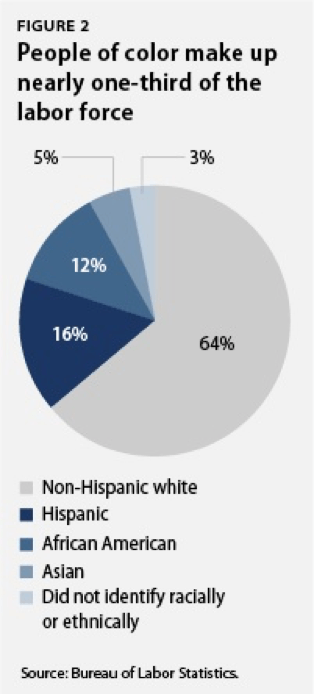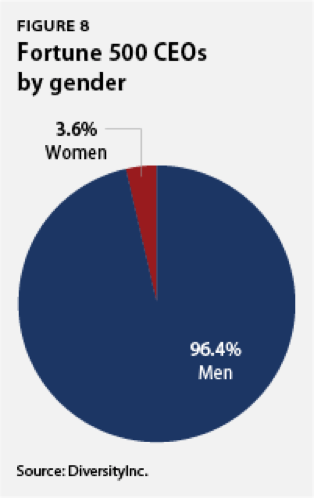For many companies, a diverse workplace is an important part of encouraging business objectives such as employee engagement, improving retention and breaking down silos in the workplace. A Deloitte survey found 39 percent of respondents would leave their current organization for a more inclusive one.
Diversity is important – but are HR professionals managing their programs in a way that ensures as much impact as possible? And can diversity mentoring, with its emphasis on informal relationships, really help organizations?
The Importance of Diversity in Organizations
Many organizations increasingly tie diversity to business results and objectives. A survey by Bersin found that organizations, especially Fortune 500 companies, invest in diversity and inclusion to drive talent and business outcomes:
- 51 percent seek enhanced employee engagement
- 44 percent seek increased innovation and agility
Additionally, inclusive organizations are 3.3 times more likely to be high performing and five times more likely to be agile.
However, other organizations still face difficulty explaining why diversity is important to them. Bersin found that 62 percent of organizations couldn’t agree that diversity and inclusion initiatives mapped to strategic business outcomes and 54 percent couldn’t agree they mapped to strategic talent outcomes.
It’s important to form effective diversity and inclusion initiatives. But it’s also important to formalize and measure them to illustrate their overall value to your leadership team.
How Diversity and Inclusion Impacts Revenue and Profit
Greater diversity in the workplace is important for reasons of social, organizational and financial benefit. Creating a workplace that includes a greater representation of race, gender, age, socioeconomic, neurological, religious backgrounds and more can improve the morale and social equity of the people in a company. In addition, more diverse ideas and perspectives can lead to greater innovation, productivity and ultimately greater returns.
A recent study found that diverse companies have a cash flow of 2.3 times higher per employee. Over a three-year period, companies with diverse employees noticed a significantly increased cash flow from individual contributors.
But companies can see an even bigger profit if they have diverse management. McKinsey & Company found companies with diverse management teams saw a 19 percent increase in revenue compared to companies with less diverse management teams. Companies with more women on their executive teams are 21 percent more likely to outperform their less diverse counterparts when it comes to profitability.
Similarly, gender diverse executive boards are also 27 percent more likely to have superior value creation. In addition, companies with diverse boards saw a significant increase in profits, with about 43 percent of companies recording higher profits.
As for inclusion? When employees believe their organization is committed to diversity and they feel included, innovation increases by 83 percent. This means it’s not just about hiring a diverse workforce, but supporting everyone and making everyone feel welcomed and encouraged to grow.
The State of Diversity in the Workplace
The workforce has a long way to go when it comes to diversity, whether that be in regards to gender, people of color, people with disabilities, a variety of ages, or otherwise.
According to a study by American Progress, people of color currently make up about one-third of the current workforce. White people make up 64 percent of the workforce, while Hispanic workers make up just 16 percent and black people make up only 12 percent. The number of Hispanic and black people goes down even more when it comes to certain industries, like tech.
Women make up almost half of the workforce, which is positive growth in comparison to just a few decades previously. In 2019, 29 percent of senior management roles were held by women. That same year, only 33 CEOs in the Forbes 500 list were women.
There are over 27 million Americans living with a disability. Only 21 percent of them are in the labor force. The unemployment rate for people with disabilities actively looking for work is 15 percent higher than people who are not disabled.
Other Important Diversity Facts
The United States has one of the highest rates of labor participation among people older than 65 years
- The unemployment rate for disabled individuals rose to 8 percent in 2018
- In 2019, the unemployment rate was 3.1 percent for foreign-born workers
- 45 percent of American workers experienced discrimination and/or harassment in 2019
- Only 40 percent of women feel satisfied with the decision-making process at their organization, compared to 70 percent of their male counterparts
- Only two-thirds of women feel they can speak up without facing repercussions, compared to 80 percent of men
- In 2017, only 9 percent of computer science degrees were earned by Black graduates, and just 10 percent were earned by Hispanics.
Every group of people faces their own challenges and problems in the workforce that must be addressed. One way organizations are trying to tackle those challenges is with diversity mentoring and mentoring focused on serving D&I initiatives.
What is a Diversity Mentorship Program?
Diversity mentorship programs help organizations create an inclusive workforce, and support diverse populations as they strive for career growth and progress. Mentorship programs can improve diversity in leadership by establishing career paths for diverse demographics and helping to retain employees, providing them with a network within their organization and someone to help them identify and improve skills and knowledge necessary for advancement.
This is done by matching diverse populations across teams, functions and hierarchy, ensuring each mentee receives a mentor that has the right skills and experience to help them grow according to their career aspirations.
Diversity mentoring also builds relationships and breaks down silos in the workplace by connecting diverse populations with each other, letting them share their experiences and perspectives with coworkers for greater understanding and empathy.
How Mentoring Helps Diversity
That’s where diversity mentoring programs come into play. By creating a diversity mentoring program that helps create formal relationships, organizations discover top talent, encourage employees to build career paths, and create an environment with equal opportunities so all employees feel empowered to collaborate.
Diversity mentoring combines all of the benefits of informal relationships with a structured goal. And when a diversity mentoring program is set up correctly, organizations can track and measure results to tie them to business objectives to prove the value of their programs.
Of course, doing this is easier said than done – mentoring within or between unique groups can come with its own challenges.
Best Practice Tips for Diversity Mentoring Programs
That’s why we’ve combined some of our best practice tips for diversity mentoring programs with lessons learned from Horizons Unlimited, a talent development consultancy and Chronus partner with decades of business experience.
Define the Purpose Carefully
Ensure there are clear objectives and actionable goals so it’s easy to measure results. A goal such as “supporting women in the organization” isn’t direct enough if you want real results. Instead, try topics such as “encouraging more women leaders” and tie it to a specific goal like tracking the number of promotions within active mentoring relationships vs. outside of active mentoring relationships.
Know Your Audience
It’s important to clearly understand the groups you’re trying to support and be careful about being sensitive to their needs. We suggest having regular roundtables with active members to ensure the program is valuable and to see if there are possible improvements. If you have software, launching surveys to all program members is an easy task but there are plenty of other survey clients out there too.
Make Programs “Opt In”
After going through the effort of creating a program like this, it might be tempting to automatically enroll everyone who qualifies. That way the most people can benefit from it, right?
But for your program to be as successful as possible, it’s imperative that mentors and mentees want to be active participants. They should be excited and eager about the program, especially since diversity mentoring requires careful thinking and listening to people with differing perspectives. You’ll want members who truly care about helping others and making an impact through the mentoring program.
Ensure Quality Overrides Quantity
Say you have 100 very excited mentees and only 40 mentors. You might want to let everyone join the program. But limit the program to the number of quality mentors available so that in-program mentees don’t feel let down if they don’t have a match. You want to keep in-program enthusiasm high. Create a waiting for list for those who aren’t in the program and send them a few updates along the way so they know they’re not forgotten.
Alternatively, you can see whether mentors are willing to take on additional mentees. We recommend setting two as the maximum even if mentors say they can take on more. You don’t want overwhelmed mentors and you want to be sure they can dedicate a good amount of their time to their mentees.
Identify the Right Mentors
Pulling mentors and mentees from the same diversity group can encourage empathy between the matched pairs. But cross-group relationships can foster a greater level of understanding which is good for the organization as a whole. Think carefully about what your organization needs more. A supportive environment for diverse employees? Or more knowledge and sensitivity throughout the organization?
Either way, diversity mentoring programs will help mentees and mentors feel supported and foster learning.
Invest in Training & Guide Relationships
A common misconception is that mentors and mentees automatically know what to do to make their relationships a success – and if it isn’t, it was probably bound to fail anyway. Luckily, that’s not true. Basic mentor/mentee training contributes significantly to positive relationships.
Training most commonly takes the form of videos or documents. But regardless of the format, it should help mentees understand their role and improve mentors’ coaching capabilities. In addition, in diversity mentoring it’s especially important to train people about cultural sensitivity issues.
After training, initial enthusiasm can wane if mentoring pairs aren’t directed. Provide your participants with workflows that guide them throughout the mentoring process and help them stay on track for a productive relationship.
Acknowledge Stereotyping
No one likes stereotyping – but it happens, so make sure you discuss this during training. Mentors in particular should be able to openly and honestly discuss the role of stereotypes if the topic should come up. That way, they’ll be knowledgeable enough to move the conversation forward and address any concerns the mentee may have.
Avoiding this topic in a diversity mentoring relationship can hinder it from reaching its full potential, so it’s important to ensure it can be openly talked about and acknowledged.
Balance Challenges With Advantages
It may be tempting to avoid discussing challenges related to diversity – or to focus too much on them. Mentors must tread a fine line between ignoring challenges and allowing them to overtake the mentoring relationship. Focusing solely on either of these limits the mentee’s potential.
Mentors should work with mentees to establish a balance sheet of both the advantages and challenges they may face in the workplace. Then, they can use this to create a go-forward plan of how to make full use of the advantages and overcome the challenges. This puts a framework in place that encourages progress towards defined goals.
Conclusion
The benefits of diversity mentoring programs are manifold. They connect employees, build communication networks, and spread ideas across the company. When tied to business objectives, they can increase promotion rates of target groups and enhance the organization’s ability to compete in global markets. While implementing a diversity mentoring program can seem daunting, we hope this list of best practices tips and items to consider will help.
For more advice, we encourage you to read our guide on Mentoring for DEIB in the Workplace in order to make your program the best it can be.



 The United States has one of the highest rates of labor participation among people older than 65 years
The United States has one of the highest rates of labor participation among people older than 65 years